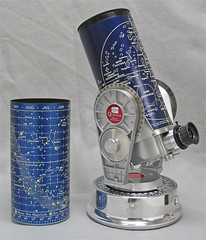
This week on Wednesday February 20th there will be a total lunar eclipse. The Eclipse will be visible in most of North America. Here, on in the east, the eclipse will be observable form 8:45 p.m. until 10:01 p.m. The next lunar eclipse will not be visible until December of 2010.
With the upcoming eclipse, I thought this was a good opportunity to talk about astronomy. I have always loved astronomy; it’s a wonderful hobby and a great family activity. I have owned several telescopes over the years, but have always coveted the Questar 3.5.
The Questar 3.5 has long been regarded as the finest small telescope in the world. It is a maksutov-cassegrain design — that’s fancy telescope-speak for using lenses and mirrors. The precision construction of this scope is amazing. The Questar 3.5 is machined from aluminum — it is a thing of beauty. The barrel of the scope is anodized and silk screened with a moon map and star chart — it is a striking and functional design. The entire package fits into a small leather case; it looks like something Hemmingway would have had on safari.
This is an heirloom quality scope produced since 1954, and they are still in use today. The new production models weigh in at $4,000. Not an inexpensive scope. The make and quality of this product insures that, with care, several generations could use and enjoy it.
Get out there and enjoy the eclipse — you don’t need a scope to see it. Astronomy is a great family activity; it’s fun and educational.




2 comments:
Your assessment of the Questar is spot-on. It is an heirloom quality scope, rugged enough to take anywhere and also good looking enough to put on display. I only recently acquired a used one after nearly 30 years of drooling over them. (You can find one on the used market -- eBay or astromart -- for about half the retail price.) It excels at views of the Moon and planets, but being "only" a 3.5-inch scope, it doesn't gather a ton of light and faint objects (galaxies, nebulae) can be dim under light polluted skies.
Someday I'll have one. Objects of this quality are so rare these days. Many new scopes have so much plastic.
Post a Comment